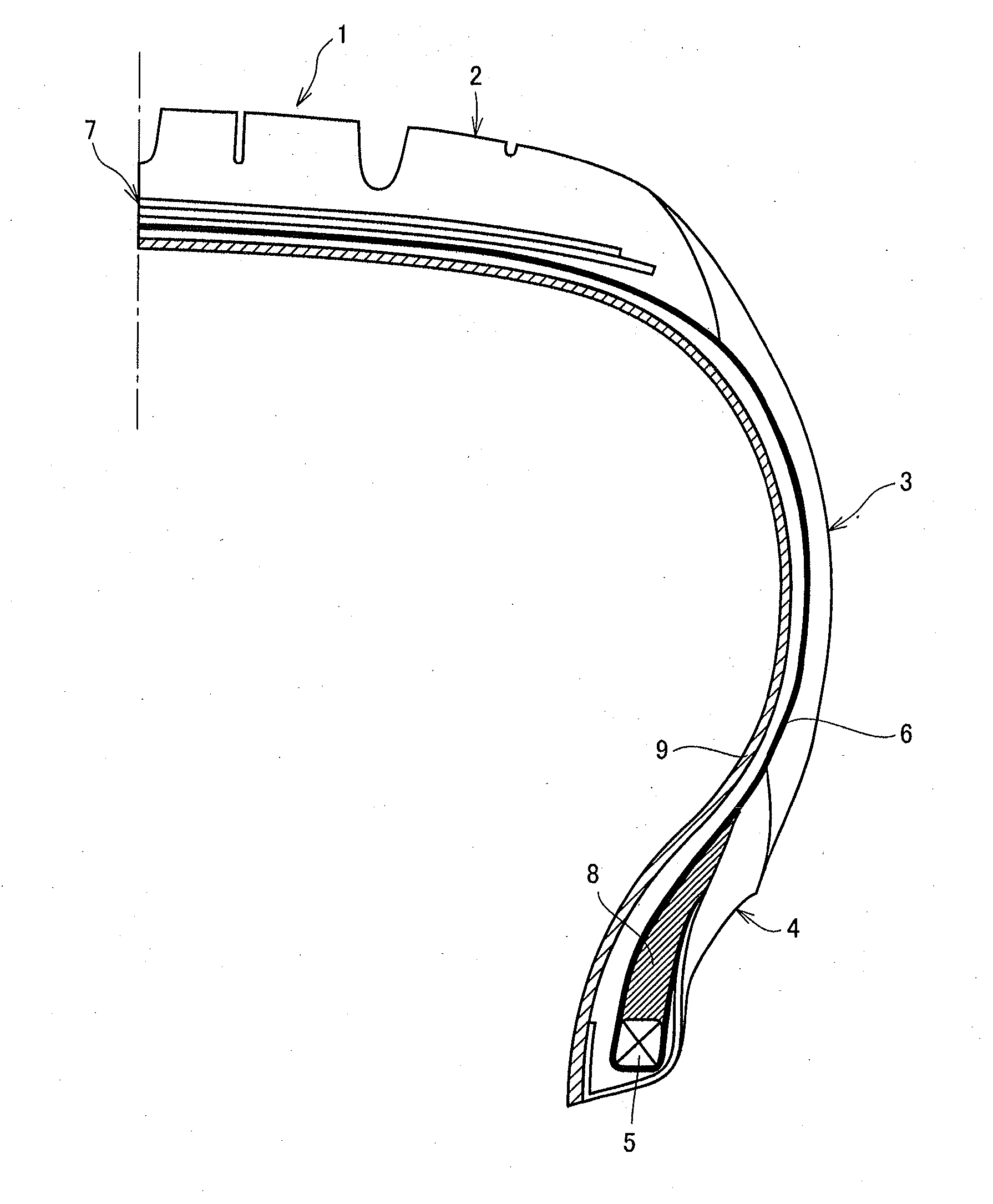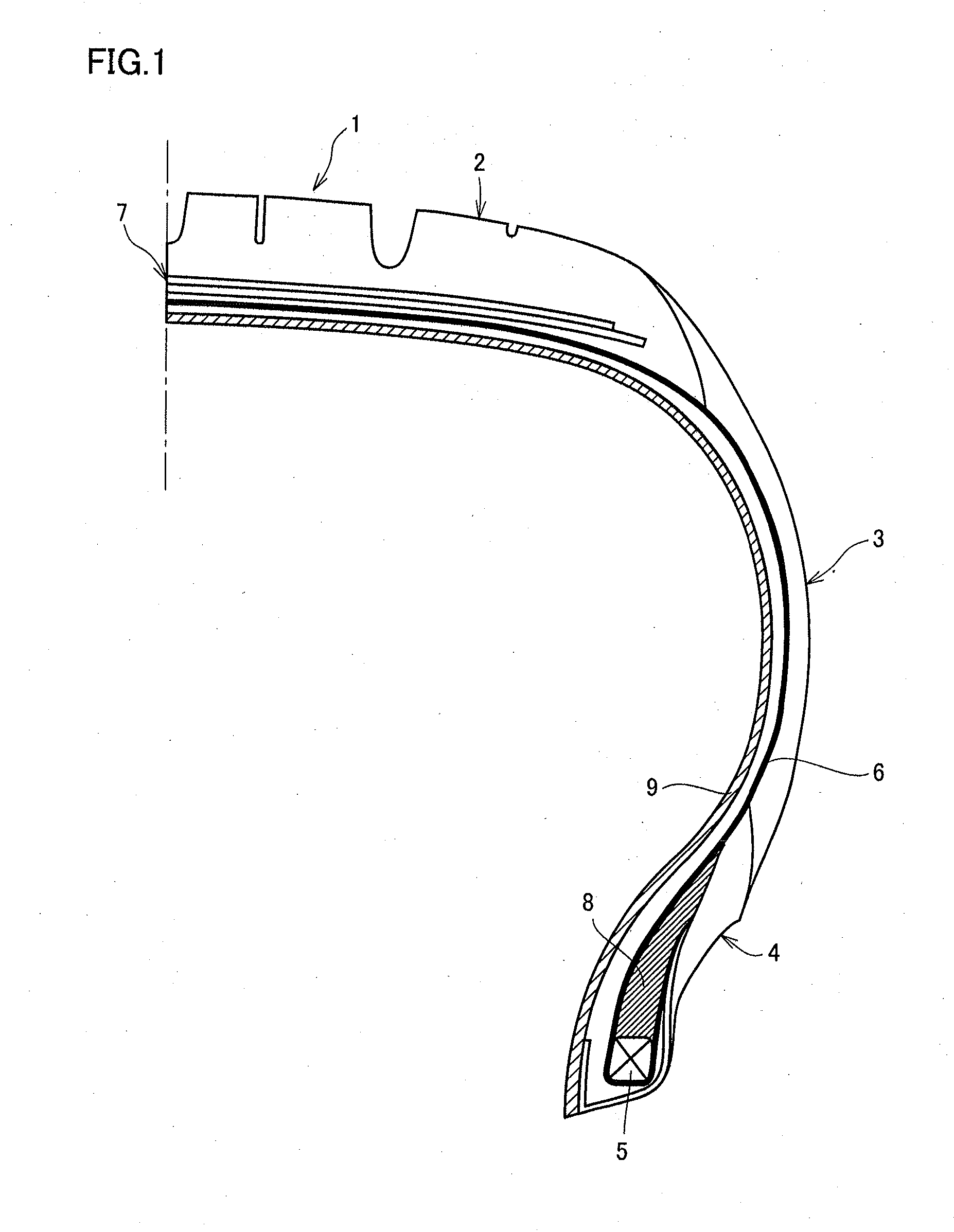Strip, method for manufacturing the same, and method for manufacturing pneumatic tire
a technology of pneumatic tires and strips, which is applied in the direction of tyre parts, filament/thread forming, textiles and paper, etc., can solve the problems of poor appearance of users, inferiority of butyl-based rubber in vulcanization adhesion strength, and complicated steps, so as to improve the adhesive property of adjacent carcass ply, improve gas barrier properties and tire durability, and reduce rolling resistance
- Summary
- Abstract
- Description
- Claims
- Application Information
AI Technical Summary
Benefits of technology
Problems solved by technology
Method used
Image
Examples
first embodiment
[0076]In an embodiment of the present invention, a strip for forming an inner liner is a strip of a thermoplastic elastomer composition to be wound spirally on a cylindrical drum to form an inner liner for a tire having a shape close to a finished sectional shape. The strip is composed of a layer stack of a first layer made of a thermoplastic elastomer composition containing 0.1 part by mass to 50 parts by mass of an organic derivative of clay mineral relative to 100 parts by mass of a styrene-isobutylene-styrene triblock copolymer, and a second layer made of a thermoplastic elastomer composition containing at least one of a styrene-isoprene-styrene triblock copolymer and a styrene-isobutylene diblock copolymer. The strip has a strip main body and ear portions disposed on opposite sides thereof. The strip main body has a thickness (T1) of 0.05 mm to 1.0 mm. The ear portions have a thickness (T2) thinner than the thickness (T1) of the strip main body and a width (W2) of 0.5 mm to 5.0...
second embodiment
[0164]In an embodiment of the present invention, a strip for an inner liner is a strip of a thermoplastic elastomer composition to be wound spirally on a cylindrical drum to form an inner liner for a tire having a shape close to a finished sectional shape. The strip is composed of a layer stack of a first layer made of a thermoplastic elastomer composition containing 60 percent by mass to 99.9 percent by mass of a styrene-isobutylene-styrene triblock copolymer and 0.5 percent by mass to 40 percent by mass of a styrene-maleic anhydride copolymer, and a second layer made of a thermoplastic elastomer composition containing a styrene-isoprene-styrene triblock copolymer. The strip has a strip main body and ear portions disposed on both sides thereof. The strip main body has a thickness (T1) of 0.05 mm to 1.0 mm. The ear portions have a thickness (T2) thinner than the thickness (T1) of the strip main body and a width (W2) of 0.5 mm to 5.0 mm. The strip, a method for manufacturing the stri...
third embodiment
[0215]In an embodiment of the present invention, a strip for forming an inner liner is a strip of a polymer composition to be wound spirally on a cylindrical drum to form an inner liner for a tire having a shape close to a finished sectional shape. The strip is formed of a polymer sheet of a polymer composition containing more than or equal to 0.1 part by mass and less than or equal to 5 parts by mass of sulfur relative to 100 parts by mass of a polymer component containing more than or equal to 5 percent by mass and less than or equal to 40 percent by mass of a styrene-isobutylene-styrene triblock copolymer and more than or equal to 60 percent by mass and less than or equal to 95 percent by mass of at least one kind of rubber component selected from the group consisting of a natural rubber, an isoprene rubber and a butyl rubber. The strip has a strip main body and ear portions disposed on both sides thereof. The strip main body has a thickness (T1) of 0.05 mm to 1.0 mm. The ear por...
PUM
 Login to View More
Login to View More Abstract
Description
Claims
Application Information
 Login to View More
Login to View More - R&D
- Intellectual Property
- Life Sciences
- Materials
- Tech Scout
- Unparalleled Data Quality
- Higher Quality Content
- 60% Fewer Hallucinations
Browse by: Latest US Patents, China's latest patents, Technical Efficacy Thesaurus, Application Domain, Technology Topic, Popular Technical Reports.
© 2025 PatSnap. All rights reserved.Legal|Privacy policy|Modern Slavery Act Transparency Statement|Sitemap|About US| Contact US: help@patsnap.com



